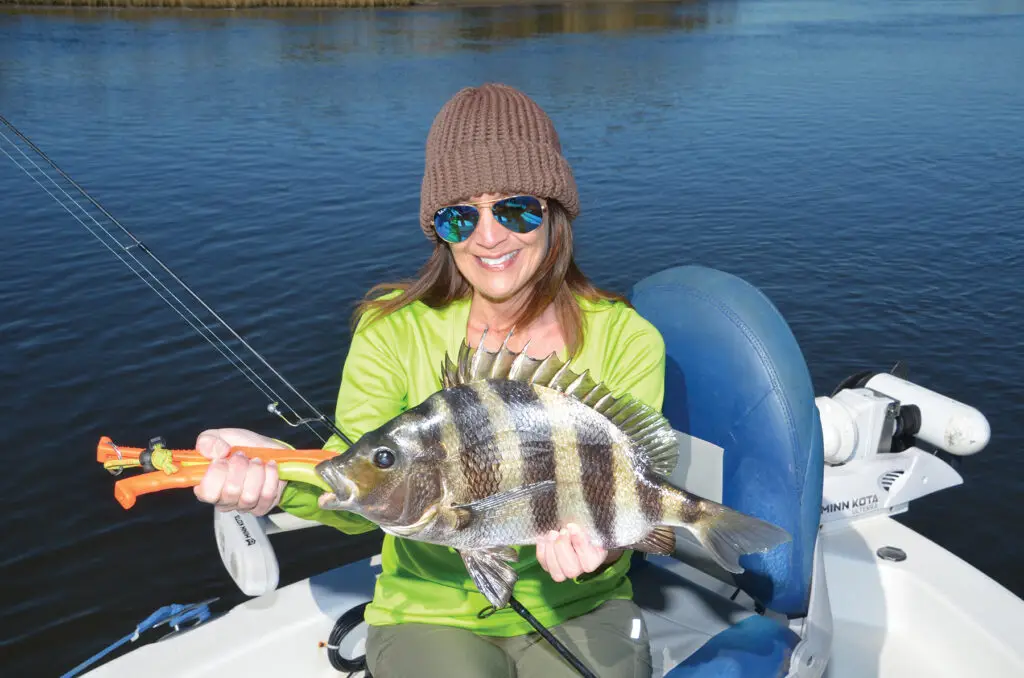
“Something keeps nibbling on my line,” the novice angler said. “I can barely feel it, but it keeps taking my bait. It must be really tiny.”
“It might be bigger than you think,” I replied.
I hooked a small live crab on the angler’s line and instructed him to drop it next to the barnacle-encrusted dock piling beneath where we stood.
“As soon as you feel a little weight on the line, set the hook,” I said.
The angler did as instructed. Moments later, his rod doubled over with a mighty fish on the line. He finally subdued the toothy beast and pulled up a 5-pound sheepshead, his first saltwater fish.
Many people scorn sheepshead. Because of their alternating black and white bars and a proclivity for stealing baits, some anglers call them “convict fish.” However, these powerful fighters provide outstanding sport on light tackle.
“Sheepshead get overlooked by many people,” says Patric Garmeson with Ugly Fishing Charters in Mobile. “With big scales and sharp dorsal spines, sheepshead are a little more difficult to clean, but they are pretty good as table fish. These strong, scrappy fighters are a heck of a lot of fun to catch.”
Sheepshead can weigh more than 20 pounds. The Alabama state record dropped the scales down to 16.66 pounds, a fish caught by Kendale M. Jeans of Elberta in March 2022.
Anglers can catch sheepshead at any time, but for the biggest fish, head out in late winter or early spring. Spawning occurs from February through April. Before spawning, sheepshead feed heavily and reach their maximum weights for the year. They also congregate in huge numbers around their favorite structures.
“Sheepshead are common along the Alabama coast,” says Marie Head, an Alabama Marine Resources Division biologist. “Sheepshead go offshore to spawn in the spring so people fishing inshore waters are more likely to catch them from the winter through April. In the spring and summer, people can catch sheepshead in the Gulf of Mexico, usually around reefs three to 10 miles from shore.”
With teeth perfectly suited for crushing barnacles and other shelled creatures set in muscular jaws, sheepshead lurk near hard structures, such as bridge or dock pilings, wrecks, reefs, jetties and similar places. Besides barnacles, they devour shrimp, crabs and clams. They occasionally grab live minnows, cut fish or squid baits, but favor crustaceans. Sometimes, they hit lures and flies, but most people catch them with natural baits.
“When I’m fishing for sheepshead, I prefer live bait,” Garmeson says. “Practically everything that swims will eat a live shrimp, but if I’m specifically targeting sheepshead, I’ll use a small crab like a hermit crab or a fiddler. Sometimes, we catch sheepshead on baitfish, but most of the time, a crustacean is the way to go.”
Despite their size and strength, sheepshead almost timidly examine baits before gingerly tasting them. They frustratingly developed a knack for snipping baits off hooks with their human-like incisor teeth without touching metal.
When hooked, though, these extremely powerful fish can put up a tremendous fight. Built for power not speed, sheepshead rely upon brute strength. They hunker down and dare anyone to bring them to the surface. Often, anglers think they snagged on something.
Since sheepshead regularly stay around structures like pilings, they provide outstanding opportunities for anglers without boats to catch big, hard-fighting fish off docks, public piers or seawalls. Many people clean fish on docks and toss the scraps into the water. This attracts crabs, shrimp and other creatures. Sheepshead gather to eat those creatures.
Sheepshead hold tight to structures, but commonly rise and descend in the water column. Anglers frequently spot them hovering around bridge or dock pilings munching on barnacles. When fishing from a dock, vertically drop baits down next to a piling. Let it sink a couple feet at a time. Periodically pause at various depths to locate where fish want to hover.
Practically any reef, wreck, piling, jetty, rock pile or platform in Alabama coastal waters might hold sheepshead at times. They also stay around buoy chains and anchors and might appear near shell beaches. The state established thousands of artificial reefs off the coast to create excellent fish habitat.
“The state put out multiple inshore reefs in both Baldwin and Mobile counties where people can find sheepshead,” Head says. “Some reefs are less than a mile offshore at Orange Beach.”
For more information on Alabama artificial reefs, visit outdooralabama.com and hover to saltwater fishing. Then click on artificial reefs.
John N. Felsher is a professional freelance writer who lives in Semmes, Ala. He also hosts an outdoors tips show for WAVH FM Talk 106.5 radio station in Mobile, Ala. Contact him at [email protected] or through Facebook.




